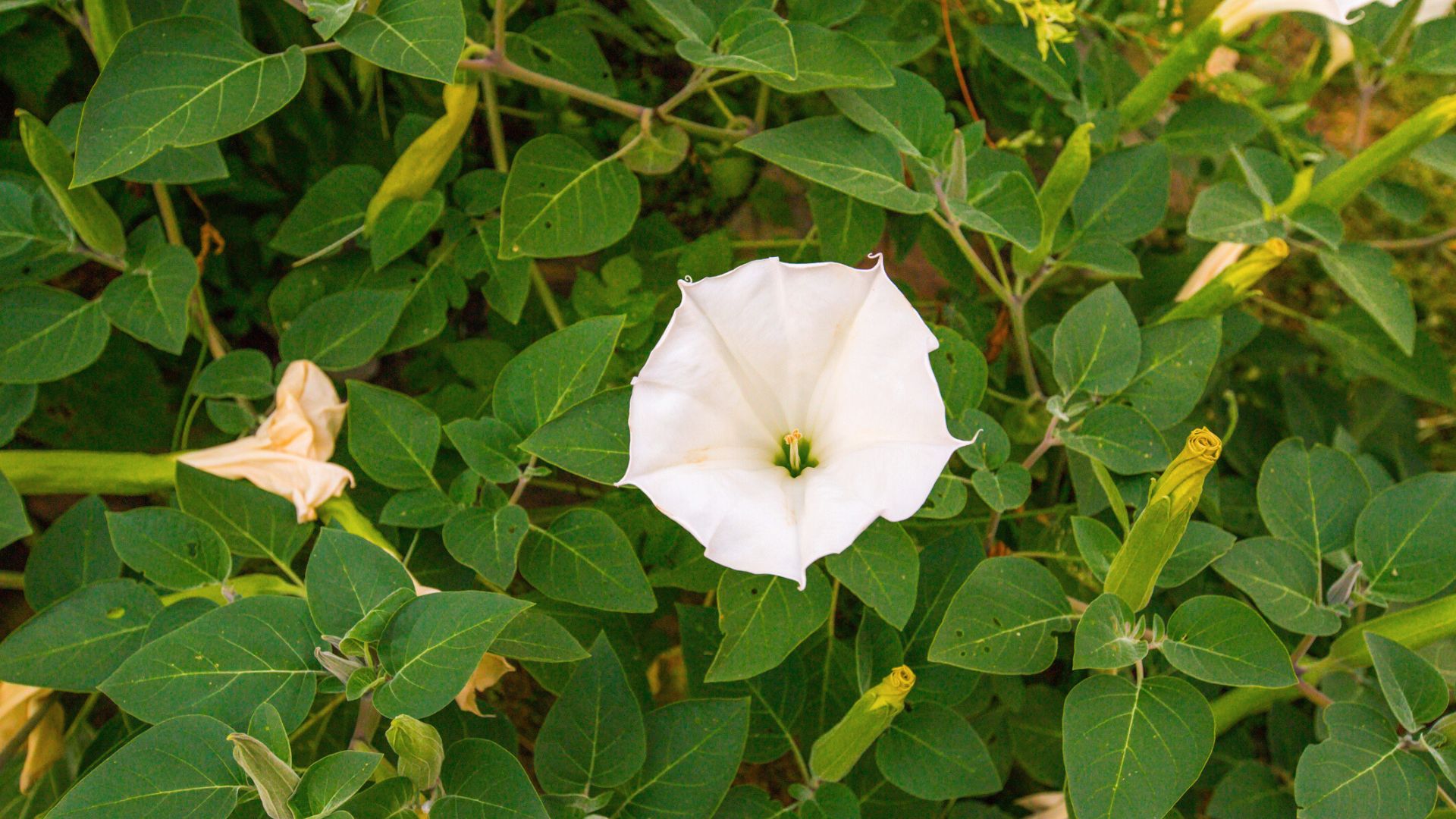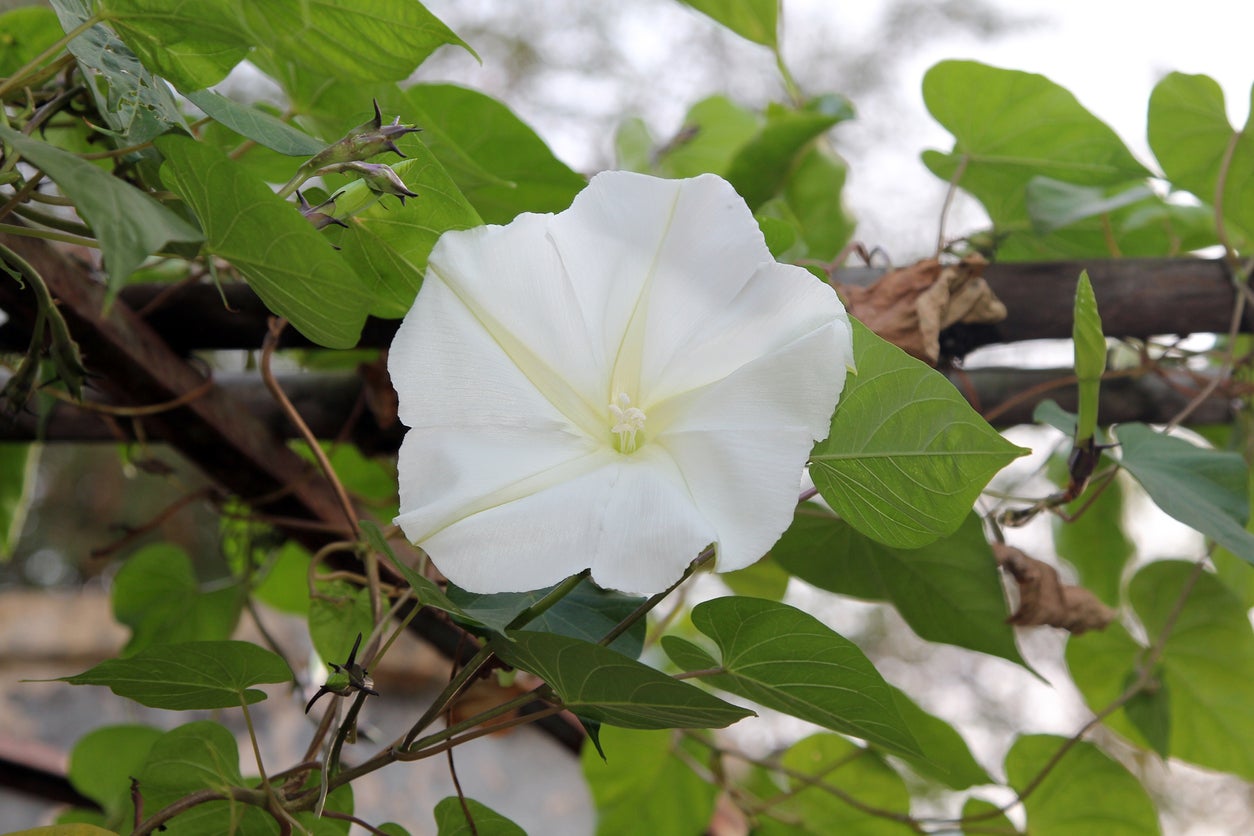Moonflower Plants: Tips For Growing Moonflowers In The Garden


If your garden area is used for evening relaxation and entertainment, add the enticing fragrance of moonflowers in the garden. Large white or purple blooms on a climbing vine offer an amazing evening smell when growing moonflowers.
Moonflower plants (Ipomoea alba) are perennial vines in sub-tropical areas, but gardeners with cold winters can successfully grow moonflower plants as annuals. A member of the Ipomea family, moonflower plants are related to the sweet potato vine and the morning glory, with flowers that open in the late afternoon. Large, heart-shaped leaves further enhance the attractive moonflower vine.
How to Grow a Moonflower Vine
Moonflowers in the garden do not need much ground space, as they readily climb upward. Provide a trellis or other support for the vigorous vines. Growing moonflowers can reach up to 20 feet (6 m.), happily twining around anything within their reach.
You can pinch back growing moonflowers at the top of the vine, as a part of your care for moonflowers, to force flowering downward. Moonflower plants are winter-hardy perennials in zones 10-11, but in cooler zones, they can be grown effectively as annuals.
They grow easily from seed when planted in somewhat fertile soil, but they are adaptable to other soil conditions. In colder climates, seeds can be started six to eight weeks before the soil outside has warmed. Plant moonflowers outside when outdoor temperatures are consistently 60 to 70 F. (15-20 C.) Some growers think the crowding of roots in the pot encourages an earlier bloom on moonflower plants.
Moonflower vines can grow in large containers or you can plant them in the ground. More moonflowers can be started from root division of existing plants. Mulch the roots of moonflowers in southern zones, and dig them up for winter storage in colder areas. Light requirements for growing moonflowers are adaptable, but more sun equals more blooms.
Care for Moonflowers
Water small plants regularly and provide additional water as moonflower vines grow. Regular fertilization at half strength with a high phosphorus fertilizer encourages more blooms on this plant. Too much nitrogen fertilizer may limit blooms and create abundant growth of the foliage.
Gardening tips, videos, info and more delivered right to your inbox!
Sign up for the Gardening Know How newsletter today and receive a free copy of our e-book "How to Grow Delicious Tomatoes".
Now that you've learned how to grow a moonflower vine and how to care for moonflowers, be sure to add some to your garden or any sunny area where you can take advantage of beautiful blooms and fantastic evening fragrance, especially in the nighttime moon garden.
Note: Many of the Ipomea species contain lysergic acid, especially the seeds, which may be toxic if ingested. Keep these plants well away from small children or pets in the garden.

Becca Badgett was a regular contributor to Gardening Know How for ten years. Co-author of the book How to Grow an EMERGENCY Garden, Becca specializes in succulent and cactus gardening.
-
 Get Ready For A Summer Of Hummers! Grow These Full Sun Hummingbird Plants and Flowers
Get Ready For A Summer Of Hummers! Grow These Full Sun Hummingbird Plants and FlowersIf you’re lucky enough to enjoy a sunny backyard, make sure you are maxing out on your pollinator opportunities and grow these full sun hummingbird plants and flowers
By Tonya Barnett
-
 12 Lush Alternatives To A Lawn For Sustainable Spaces
12 Lush Alternatives To A Lawn For Sustainable SpacesAlternatives to a lawn are beautiful and also beneficial to your local ecosystem and its pollinators. Explore our top picks for plants to replace grass.
By Tonya Barnett
-
 Cutting Back Moonflowers – How To Prune A Moonflower Plant
Cutting Back Moonflowers – How To Prune A Moonflower PlantAnyone who has grown moonflower, or their day-blooming cousin, has probably quickly learned that these vines need regular pruning to keep them in check and looking their best. Click the following article to learn how to prune a moonflower plant.
By Darcy Larum
-
 Moonflower Seed Harvesting: Collecting Moonflower Seed Pods For Growing
Moonflower Seed Harvesting: Collecting Moonflower Seed Pods For GrowingPropagating moonflower vine seeds is the only way to replicate the vines, as vegetative reproduction is not viable. Learn when and how to harvest and plant moonflower seeds in the article that follows to continually grow this plant in your garden.
By Bonnie L. Grant